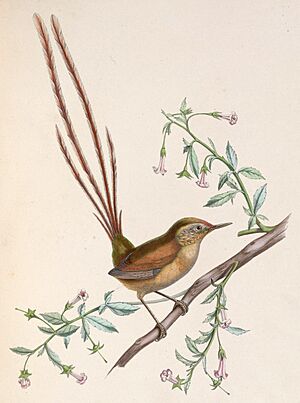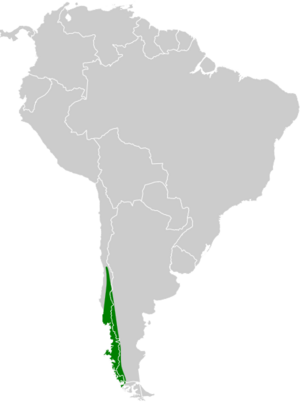Des Murs's wiretail facts for kids
Quick facts for kids Des Murs's wiretail |
|
|---|---|
 |
|
| Conservation status | |
| Scientific classification | |
| Genus: |
Sylviorthorhynchus
|
| Species: |
desmurii
|
 |
|
The Des Murs's wiretail (Sylviorthorhynchus desmurii) is a small passerine bird found in southern South America. It belongs to the ovenbird family, called Furnariidae. Scientists believe this bird's group separated from another bird group, Leptasthenura, around 14 to 15 million years ago.
Contents
What's in a Name?
The Des Murs's wiretail got its scientific name, Sylviorthorhynchus desmurii, from a French scientist named Claude Gay in 1845. He named it to honor another French bird expert, Marc Athanase Parfait Œillet des Murs. This bird is unique because it doesn't have any different types or subspecies within its group.
What Does It Look Like?
This bird is about 24 centimeters (9.4 inches) long. Most of its length comes from its very long tail. Despite its length, it's quite light, weighing only about 10 grams (0.35 ounces).
A Special Tail
The wiretail's tail is very unusual. It has only six feathers, which are super thin and look like filaments. Only a few other birds, like the emu-wrens in Australia, have so few tail feathers. The two feathers in the middle are much longer than the others. The two outer feathers are very short.
Feathers and Beak
Its body feathers are reddish-brown on top. They are lighter in color on its belly. It has a pale stripe above each eye. The bird has a small, round body and a very thin bill. Its song is fast and high-pitched.
Where Does It Live?
You can find the Des Murs's wiretail in western Argentina, from Santa Cruz Province north to San Juan. It also lives in southern and central Chile, from northern Magallanes to Valparaíso Region.
Its Home
This bird loves to live in thick, dense bushes of Chusquea bamboo. These bamboo thickets are usually found in cool, temperate rainforests. It can live from sea-level up to 1,200 meters (3,900 feet) high. Sometimes, it also lives in new shrublands with shade-loving plants like Amomyrtus. You might even find it in thick patches of gorse plants in the northern parts of its range.
Staying Low
Even in untouched rainforests, wiretails stay close to the ground. They search for food in the low bushes and bamboo. They almost never fly higher than 3 meters (10 feet) above the ground.
How Does It Behave?
The Des Murs's wiretail is very shy and hard to spot. It cannot go into open areas without lots of plants covering the ground. It also struggles to use narrow paths less than 25 meters (82 feet) wide. It usually won't fly further than 50 meters (164 feet) between good patches of its habitat.
Mouse or Bird?
When you do see a Des Murs's wiretail, you might mistake it for a mouse. It has a unique ability among birds: it can curl its long tail into a ball when it feels scared!
Nest and Territory
Its nest is shaped like a ball and made of plant fibers. It builds its nest close to the ground among plants. Both the male and female birds protect their home area very strongly. Each pair usually has a territory of about 1 hectare (2.5 acres). However, pairs with smaller territories (less than 20 hectares or 49 acres) often don't have successful nests.
They defend their territory with a special song. It's possible that their long tails help them choose a mate, but scientists haven't fully studied this yet.
Eggs and Chicks
Like many insect-eating birds in southern temperate areas, the Des Murs's wiretail lays its eggs between October and February. They usually lay two to four eggs. For a bird of its size, these eggs are very large! They are about 20.5 millimeters (0.8 inches) long and 15.8 millimeters (0.6 inches) wide. A clutch of four eggs can weigh more than the adult female bird herself! This is a rare feat, only matched by much more fertile birds like kinglets.
Because these birds are so secretive, not much is known about how long it takes for the eggs to hatch or for the chicks to leave the nest.


